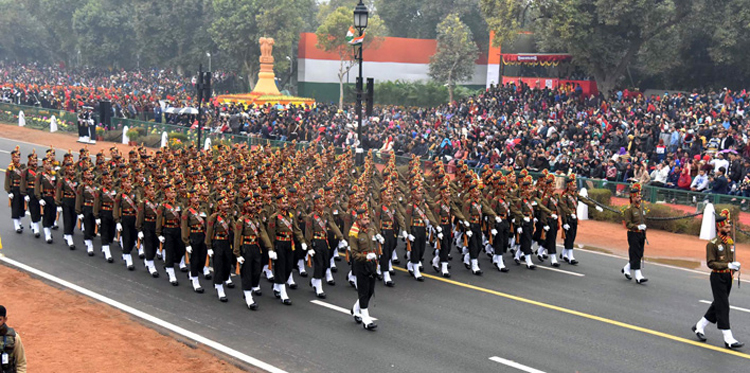INDIAN ARMED FORCES CHIEFS ON OUR RELENTLESS AND FOCUSED PUBLISHING EFFORTS

The insightful articles, inspiring narrations and analytical perspectives presented by the Editorial Team, establish an alluring connect with the reader. My compliments and best wishes to SP Guide Publications.

"Over the past 60 years, the growth of SP Guide Publications has mirrored the rising stature of Indian Navy. Its well-researched and informative magazines on Defence and Aerospace sector have served to shape an educated opinion of our military personnel, policy makers and the public alike. I wish SP's Publication team continued success, fair winds and following seas in all future endeavour!"

Since, its inception in 1964, SP Guide Publications has consistently demonstrated commitment to high-quality journalism in the aerospace and defence sectors, earning a well-deserved reputation as Asia's largest media house in this domain. I wish SP Guide Publications continued success in its pursuit of excellence.
Switching military uniforms to Khadi would be retrograde
 |
By Lt. General P.C. Katoch (Retd) Former Director General of Information Systems, Indian Army |

According to a media reports, the Khadi Villages Industries Commission (KVIC) had requested the Armed Forces to consider using Khadi uniforms for security personnel, and the Ministry of Defence (MoD) has sent specifications of military uniforms to the KVIC. MoS (Defence) Subhash Bhamre recently said in a written reply in Lok Sabha, that read, "Required specifications of uniform, along with samples, have been sent to KVIC." The manner in which MoD has responded and the fact that it was discussed in Lok Sabha indicates that the MoD is amenable to the defence forces switching to wearing Khadi uniforms. The news out of the blues has raised many questions, including are we going in for a change for the sake of just making a change without analyzing the issue? Indigenization surely cannot be the basis of switching to Khadi because unlike many countries, India does not import cloth for uniforms of soldiers of Armed Forces.
So it is not a question of money going out of the country. The textile industry of India is well advanced and competing globally. It is but natural that KVIC would like to capture a large organization like the Armed Forces; 1.4 million manpower with multiple uniforms required for individual soldiers. The gain would be in thousands of crores with initial supply and the continuing cycles of re-supply considering the life cycle of such uniforms. KVIC reportedly has already introduced Khadi uniforms in many organizations including Air India, but has MoD taken into consideration what are the physical working conditions of individuals in these organizations compared to what the soldiers in the military are required to undertake? It is not known whether inputs from the Armed Forces were taken at all but in all probability the Armed Forces were not consulted as they would not have acquiesced to such suggestion. The MoS (Defence) would do well to scrutinize the evolution of uniforms of our Armed Forces since Independence and how these have reached the present state.
In the initial years, the soldiers were wearing cotton uniforms. The switch was made to terrycot uniforms because the maintenance of cotton uniforms was extremely difficult and their crumpled state was conspicuous, especially in ceremonials. The Khadi uniform will be worse. But that is just one aspect. Try putting a soldier in Khadi uniform through a battle obstacle course including crawling under a low wire entanglement and his dress will likely be in tatters by the time he gets to the other end. Khadi cloth can in no way match the resilience of terrycot cloth in military uniforms in meeting requirement and rigours of soldiering.
A terrycot pocket would also carry much more weight compared to a Khadi pocket, and a soldier has to carry plenty weight. We are in an era where modern armies are experimenting in 'E-Textiles' and wearable technologies. Nanotechnology has made fabrics smarter. Conductive yarns mean the fabrics that we wear and sit and sleep on can communicate with our devices; high performance fibres (a regular thread with a metallic alloy) can create touch and gesture sensitive patches on items of clothing – controlling embedded electronics are easily disguised. 'E-textiles' can provide uniforms with a single, central power source that allows soldiers to recharge one battery instead of many and cut the number of cables required in their kit. In 2012, BBC reported development of conductive yarns by 'Intelligent Textiles' that takes power and data to where required, with redundancy, so that if the fabric gets cut, damaged or torn, there is still a way of re-routing the data. It removes the hindrance of the many wires and cables required in military equipment that adds weight, can tangle and snag. For field trials scheduled in May 2012, the fabric was integrated into the vest, the shirt, the helmet, the backpack, and into the glove and weapons platform. The ring-main circuit allows powering data where required. Power can be sent to even the helmet without it being tethered. Also being developed was a fabric keyboard for use with a portable computer integrated with the uniform.
By 2014-2015, these lightweight uniforms were to see more widespread use. Intelligent Textiles is currently working with BAE Systems to integrate other next-generation equipment into military uniforms. This is the type of research in military uniforms that our Armed Forces need. The Ordnance Factory Board (OFB) appears incapable of such research in its present avatar unless the Ordnance Factories are privatized. Britain incidentally has 'The Centre for Defence Enterprise' to provide a new process for harnessing innovative ideas with potential defence or security applications, which calls for research proposals from academia and companies for ideas that are high-risk but which may also have great benefits. We need such R&D with or without the KVIC. A mere switch to Khadi would be retrograde.





